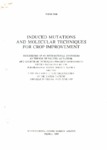Use este identificador para citar ou linkar para este item:
http://www.alice.cnptia.embrapa.br/alice/handle/doc/478778Registro completo de metadados
| Campo DC | Valor | Idioma |
|---|---|---|
| dc.contributor.author | TORRES, G. A. | pt_BR |
| dc.contributor.author | PARENTONI, S. N. | pt_BR |
| dc.contributor.author | LOPES, M. A. | pt_BR |
| dc.contributor.author | PAIVA, E. | pt_BR |
| dc.date.accessioned | 2011-04-10T11:11:11Z | pt_BR |
| dc.date.accessioned | 2011-04-10T11:11:11Z | pt_BR |
| dc.date.available | 2011-04-10T11:11:11Z | pt_BR |
| dc.date.available | 2011-04-10T11:11:11Z | pt_BR |
| dc.date.created | 1998-01-29 | pt_BR |
| dc.date.issued | 1995 | pt_BR |
| dc.identifier.citation | In: INTERNATIONAL SYMPOSIUM ON THE USE OF INDUCED MUTATIONS AND MOLECULAR TECHNIQUES FOR CROP IMPROVEMENT, 1995, Viena. Proceedings... Viena: IAEA: FAO, 1995. p. 227-236. | pt_BR |
| dc.identifier.uri | http://www.alice.cnptia.embrapa.br/alice/handle/doc/478778 | pt_BR |
| dc.description | The objective of this study was to identify restriction fragment length polymorphism (RFLP) markers linked to quantitative trait loci that control. Al tolerance in maize. The strategy used was bulked segregant analysis, which is based on selecting for bulk bred true F2 individuals. The genetic material used consisted of an F2 population derived from a cross between Al susceptible (L53) and Al tolerant (L1327) maize inbred lines, Both lines were developed in the maize breeding programme of the Centro Nacional de Pesquisa de Milho e Sorgo. The relative seminal root length (RSRL) index was used as the phenotypic measure of tolerance. The frequency distribution of RSRL showed continuous distribution, which is typical of a quantitatively inherited character, with a tendency towards Al susceptible individuals. The estimated heritability was found to be 60%. This moderately high heritability value suggests that, although the caracter has a quantitative nature, it may be controlled by a small number of genes, Those seedlings of the F2 population that stored the highest and lowest values for RSRL were subsequently selfed to obtain the F3 families. These falmilies were evaluated in nutrient solution to identify those that were not segregating. On the basis of the results, five individuals were chosen for each bulk. Sixty-five probes were selected at an average interval 0f 30 cM, covering all ten maize chromosomes. For the hybridization work, a non-radioctive labelling system, using dig-dUTP and alkaline phosphatase, proved to be quite efficient and reliable, resulting in Southern blots with good resolution and allowing the menbranes to be stripped and reprobed as least three times. Twenty-three markers showed a co-dominant effect, identifying 40 RFLP loci that could distinguish the parental inbred lines. These 23 probes are now being hybridized with DNA from the two contrasting bulks. Also, a search for other informative markers is being carried out to increase genome coverage. | pt_BR |
| dc.language.iso | eng | eng |
| dc.rights | openAccess | eng |
| dc.subject | Tolerancia | pt_BR |
| dc.subject | Maize | pt_BR |
| dc.subject | RFLP | pt_BR |
| dc.subject | Aluminium | pt_BR |
| dc.subject | Tolerance | pt_BR |
| dc.title | Use of RFLPs to identify genes for aluminium tolerance in maize. | pt_BR |
| dc.type | Artigo em anais e proceedings | pt_BR |
| dc.date.updated | 2018-06-12T11:11:11Z | pt_BR |
| dc.subject.thesagro | Alumínio | pt_BR |
| dc.subject.thesagro | Milho | pt_BR |
| dc.subject.thesagro | Zea Mays | pt_BR |
| riaa.ainfo.id | 478778 | pt_BR |
| riaa.ainfo.lastupdate | 2018-06-12 -03:00:00 | pt_BR |
| dc.contributor.institution | SIDNEY NETTO PARENTONI, CNPMS. | pt_BR |
| Aparece nas coleções: | Artigo em anais de congresso (CNPMS)  | |
Arquivos associados a este item:
| Arquivo | Descrição | Tamanho | Formato | |
|---|---|---|---|---|
| UseRFLPs.pdf | 6.42 MB | Adobe PDF |  Visualizar/Abrir |









